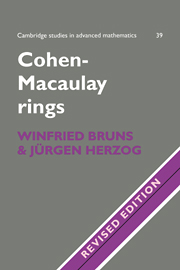Book contents
- Frontmatter
- Contents
- Preface to the revised edition
- Preface to the first edition
- I Basic concepts
- 1 Regular sequences and depth
- 2 Cohen–Macaulay rings
- 3 The canonical module. Gorenstein rings
- 4 Hilbert functions and multiplicities
- II Classes of Cohen–Macaulay rings
- III Characteristic p methods
- Appendix A summary of dimension theory
- References
- Notation
- Index
3 - The canonical module. Gorenstein rings
Published online by Cambridge University Press: 04 December 2009
- Frontmatter
- Contents
- Preface to the revised edition
- Preface to the first edition
- I Basic concepts
- 1 Regular sequences and depth
- 2 Cohen–Macaulay rings
- 3 The canonical module. Gorenstein rings
- 4 Hilbert functions and multiplicities
- II Classes of Cohen–Macaulay rings
- III Characteristic p methods
- Appendix A summary of dimension theory
- References
- Notation
- Index
Summary
The concept of a canonical module is of fundamental importance in the study of Cohen–Macaulay local rings. The purpose of this chapter is to introduce the canonical module and derive its basic properties. By definition it is a maximal Cohen–Macaulay module of type 1 and of finite injective dimension.
In the first two sections we investigate the injective dimension of a module, and prove Matlis duality which plays a central role in Grothendieck's local duality theorem. Actually the canonical module has its origin in this theory. Here the canonical module is introduced independently of local cohomology which is an important notion in itself and will be treated later in this chapter.
A ring which is its own canonical module is called a Gorenstein ring. Next to regular rings and complete intersections, Gorenstein rings are in many ways the ‘nicest’ rings. Distinguished by the fact that they are of finite injective dimension, they have various symmetry properties, as reflected in their free resolution, their Koszul homology, and their Hilbert function. The last aspect will be discussed in the next chapter.
Gorenstein rings of embedding dimension at most two are complete intersections. The first non-trivial Gorenstein rings occur in embedding dimension three, and they are classified by the Buchsbaum–Eisenbud structure theorem.
In the final section the canonical module of a graded ring is introduced.
Finite modules of finite injective dimension
In this section we study injective resolutions of finite modules. We shall see that the injective dimension of a finite module M over a Noetherian local ring R either is infinite or equals the depth of R, and is bounded below by the dimension of M.
- Type
- Chapter
- Information
- Cohen-Macaulay Rings , pp. 88 - 146Publisher: Cambridge University PressPrint publication year: 1998

